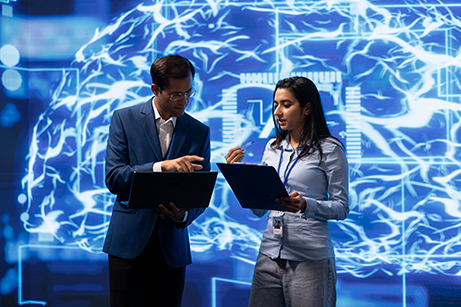AIMC Topic: Time Perception
Clear Filters Showing 1 to 10 of 25 articles
Minimal Neural Network Conditions for Encoding Future Interactions.
International journal of neural systems
Feb 28, 2025
Space and time are fundamental attributes of the external world. Deciphering the brain mechanisms involved in processing the surrounding environment is one of the main challenges in neuroscience. This is particularly defiant when situations change ra...
Temporal pavlovian conditioning of a model spiking neural network for discrimination sequences of short time intervals.
Journal of computational neuroscience
Feb 1, 2025
The brain's ability to learn and distinguish rapid sequences of events is essential for timing-dependent tasks, such as those in sports and music. However, the mechanisms underlying this ability remain an active area of research. Here, we present a P...
Self-supervised learning of scale-invariant neural representations of space and time.
Journal of computational neuroscience
Jan 22, 2025
Hippocampal representations of space and time seem to share a common coding scheme characterized by neurons with bell-shaped tuning curves called place and time cells. The properties of the tuning curves are consistent with Weber's law, such that, in...
Sparser spiking activity can be better: Feature Refine-and-Mask spiking neural network for event-based visual recognition.
Neural networks : the official journal of the International Neural Network Society
Jul 20, 2023
Event-based visual, a new visual paradigm with bio-inspired dynamic perception and μs level temporal resolution, has prominent advantages in many specific visual scenarios and gained much research interest. Spiking neural network (SNN) is naturally s...
The impact of facial expression and communicative gaze of a humanoid robot on individual Sense of Agency.
Scientific reports
Jun 21, 2023
Sense of Agency (SoA) is the feeling of control over one's actions and their outcomes. A well-established implicit measure of SoA is the temporal interval estimation paradigm, in which participants estimate the time interval between a voluntary actio...
Static anti-windup compensator design for locally Lipschitz systems under input and output delays.
PloS one
Apr 11, 2023
This paper proposes a static anti-windup compensator (AWC) design methodology for the locally Lipschitz nonlinear systems, containing time-varying interval delays in input and output of the system in the presence of actuator saturation. Static AWC de...
Fault-Level Grading of Photovoltaic Cells Employing Lightweight Deep Learning Models.
Computational intelligence and neuroscience
Feb 7, 2023
The deployment of photovoltaic (PV) cells as a renewable energy resource has been boosted recently, which enhanced the need to develop an automatic and swift fault detection system for PV cells. Prior to isolation for repair or replacement, it is cri...
Learning to recognize while learning to speak: Self-supervision and developing a speaking motor.
Neural networks : the official journal of the International Neural Network Society
May 14, 2021
Traditionally, learning speech synthesis and speech recognition were investigated as two separate tasks. This separation hinders incremental development for concurrent synthesis and recognition, where partially-learned synthesis and partially-learned...
EO-MTRNN: evolutionary optimization of hyperparameters for a neuro-inspired computational model of spatiotemporal learning.
Biological cybernetics
Mar 17, 2020
For spatiotemporal learning with neural networks, hyperparameters are often set manually by a human expert. This is especially the case with multiple timescale networks that require a careful setting of the values of timescales in order to learn spat...
A simple three layer excitatory-inhibitory neuronal network for temporal decision-making.
Behavioural brain research
Jan 20, 2020
Humans and animals do not only keep track of time intervals but they can also make decisions about durations. Temporal bisection is a psychophysical task that is widely used to assess the latter ability via categorization of durations as short or lon...
Popular Topics
- Machine Learning 32021
- Neural Networks, Computer 30231
- Algorithms 27405
- Deep Learning 26912
- Artificial Intelligence 24844
- Robotics 13389
- Image Processing, Computer-Assisted 9738
- Retrospective Studies 9346
- Magnetic Resonance Imaging 6347
- Reproducibility of Results 5670
- Tomography, X-Ray Computed 4866
- Support Vector Machine 4771
- Computational Biology 4333
- Brain 4129
- Computer Simulation 3935
Recent Journals
- Scientific reports 6800
- Sensors (Basel, Switzerland) 4794
- PloS one 4210
- Neural networks : the official journal of the International Neural Network Society 3026
- Computational intelligence and neuroscience 1931
- Computers in biology and medicine 1916
- Annual International Conference of the IEEE Engineering in Medicine and Biology Society. IEEE Engineering in Medicine and Biology Society. Annual International Conference 1686
- Studies in health technology and informatics 1378
- IEEE journal of biomedical and health informatics 1172
- Journal of chemical information and modeling 1066
- Nature communications 1047
- Computer methods and programs in biomedicine 883
- Bioinformatics (Oxford, England) 874
- Journal of medical Internet research 864
- Briefings in bioinformatics 853
